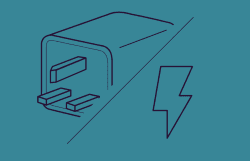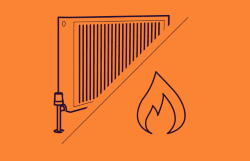An Economy 7 energy plan will offer access to cheaper energy over-night for a certain time period, lasting 7 hours. The Economy 10 energy plan is almost identical, but the length of the cheaper energy window lasts 10 hours. The trade-off with this, is that your rates for daytime energy will be considerably higher. If you are aware of the time slot that you have access to cheaper energy, you can heavily stack your usage during this time for massive savings on your energy bill. Depending on your lifestyle this type of tariff can open up a world of savings, or place unnecessary strain on your monthly budget. It is important to recognise that these types of tariffs are not for everyone!
What is an Economy 7 tariff?
Often the terminology used to describe these tariffs are interchangeable, and causes a little bit of confusion. If you see the phrases ‘differential tariff’ ‘multi-rate tariff’ or ‘day/night tariff’ it is likely to be describing the exact same thing!
Economy 7, as the name suggests, offers economy prices for 7 hours overnight. Depending on your energy supplier, the difference between cheaper night-time rates and normal rates can be up to 50%.
This means you will be paying different prices for each unit of energy you use depending on the time you use it.
What is an Economy 10 tariff?
Economy 10 is very similar to Economy 7. Economy 10 is also often referred to as ‘Day/Evening/Night’ or ‘Day/Evening/Weekend’ tariffs.
With Economy 10, you have to have a special E10 meter installed at your residence. A further drawback is that there are few suppliers that offer this tariff, and few residences that are even suitable in the first place.
Economy 10 is not suitable for residences with gas, oil, or electric storage heating. It is more aimed towards with electrically heated wet radiator systems or ceramic core heaters.
The 10 hours of cheaper energy are split across the day into three separate periods, which makes it slightly easier to access the lower rates.
What are the times I have access to cheaper energy?
| Location | Length of Time | Window |
| North of Scotland | 7 Hours | 22:00 – 08:30 |
| South of Scotland | 7 Hours | 22:00 – 08:30 |
| North East England | 7 Hours | 00:30 – 07:30 |
| Yorkshire | 7 Hours | 00:30 – 07:30 |
| North West England | 7 Hours | 00:30 – 07:30 |
| Merseyside & North Wales | 7 Hours | 00:00 – 08:00 |
| East Midlands | 7 Hours | 23:00 – 07:00 |
| West Midlands | 7 Hours | 23:30 – 08:00 |
| Eastern England | 7 Hours | 23:00 – 07:00 |
| South Wales | 7 Hours | 22:00 – 08:30 |
| Southern England | 7 Hours | 23:30 – 06:30 |
| London | 7 Hours | 23:00 – 07:00 |
| South East England | 7 Hours | 22:30 – 05:30 OR 00:30 – 07:30 |
| South Western England | 7 Hours | 22:00 – 08:30 |
| Location | Credit Meter | Pay-as-you-go Meter |
| Southern Scotland (MPAN 18) | 4.30am – 7.30am 1.00pm – 4.00pm 8.30pm – 12.30am | 4.30am – 7.30am 1.00pm – 4.00pm 8.30pm – 12.30am |
| Northern Scotland (MPAN 17) | 4.30am – 7.30am 1.30pm – 4.30pm 8.30pm – 12.30am | 4.30am – 7.30am 1.30pm – 4.30pm 8.30pm – 12.30am |
| Merseyside and Northern Wales (MPAN 13) | 4.30am – 7.30am 1.00pm – 4.00pm 8.30pm – 12.30am | 4.30am – 7.30am 1.00pm – 4.00pm 8.30pm – 12.30am |
| All other areas | 12.00am – 5.00am 1.00pm – 4.00pm 8.00pm – 10.00pm | 12.00am – 5.00am 1.00pm – 4.00pm 8.00pm – 10.00pm |
How will I know when my window is for cheaper energy?
It is important to remember that there is huge variance between window allocations, as it is completely dependent on where you live. Somebody in the North of Scotland will have access to cheaper energy at different times to somebody with the same Economy 7 tariff who lives in North-West England.
We have included two tables that show how much these times can vary between geographical locations, for both Economy 7 and Economy 10.
The easiest way to check when your window occurs, is to contact your supplier. If you are already on either variable tariff then the information should be readily available. If you are currently looking for a new variable tariff – then the timings on offer will vary between suppliers, but they will have to provide this information prior to signing any contracts.
Who currently offers Economy 10 tariffs?
| Supplier |
| British Gas |
| Economy 7 Energy |
| E.ON |
| Ecotricity |
| EDF Energy |
| Good Energy |
| Green Energy UK |
| iSupply Energy |
| nPower |
| Octopus Energy |
| Outfox The Market |
| OVO Energy |
| People’s Energy |
| PFP Energy |
| Powershop |
| So Energy |
| SSE |
| Scottish Power |
| Spark Energy |
| Together Energy |
| Tonik Energy |
| Utility Warehouse |
Will switching to Economy 7 or Economy 10 save me money?
It depends – variable price contracts are certainly not for everybody.
A good question to ask yourself is ‘when do I use most of my energy?’
If the answer to this is during the day, then it is unlikely that switching to a variable price contract will immediately save you any money. Even though you will have access to savings over any energy used overnight, this will be negated by the higher use of daytime rates – which are far more expensive.
If you think that you are able to successfully change your energy consumption habits to fit around the timings offered by your supplier – then it is likely you will see a considerable decrease in your monthly bills. This then simply becomes a matter of – is it worth it? It is no small feat to consistently adhere to consumption patterns set-out by your energy supplier.
Other things to consider before switching to Day/Night Tariffs:
| Factor | Description |
| Lifestyle | If you drive an electric vehicle regularly – often charging this overnight will perfectly suit Economy 7. |
| Timers | Unless you are happy getting up in the middle of the night to turn on/off appliances – timers should be pretty commonplace. |
| Habits | Do you go to the gym early? Go to sleep late at night? All things that need to be factored in to your decision. |
| Heating Type | Some types of heating (like electric storage heaters and hot water tanks) are ideal for Economy 7 – as you can heat them overnight using cheaper energy, but use them when you want during the day. |
How do I read an Economy 7 meter?
Depending on the manufacturer of the meter you use, interface and menus may vary slightly.
A common meter-style is a dual display meter. This will have two displays for day-time rate usage, and night-time rates. Often the top display will be labelled ‘normal’ and show your higher-priced day-time usage, and the second display labelled ‘low’ will show your night-time usage.
For smart-meters, there is simply no replacement for using the manufacturer manual to navigate through menus. Both SMETS2 and SMETS2 meters are potentially viable with Economy 7 tariffs, so start by checking what type you have! Use this information to then find the manufacturer or specific model and the associated user guide.
How do I read an Economy 10 meter?
Similar to reading Economy 7 meters, we recommend identifying your meter-type and model to find the associated user guide to help with menu navigation.
Economy 10 meters will have not one, not two, but three separate readings for energy consumption. It is likely that you will need to apply to have a special Economy 10 meter installed due to the nature of the tariff. The cost of installation is most often covered by the customer, you.
The three readings on display will vary depending on supplier – some will show day/normal use, others night/low or day/off peak use. By using the user-guide, it should be simple enough to find how to cycle through the menus. All of these readings will need to be supplied to your supplier should they require it.
Can I switch back from Economy 10?
It is entirely possible to switch from Economy 10 back to normal rates for energy pricing. The reasons for wanting to switch back are endless – and it is entirely normal to want to do so!
The first thing you should do is contact your supplier – as they are the ones who handle your supply and billing. Often you will be provided with information on how easy or difficult the process is going to be dependant on individual supplier policy. If it’s a straight forward switching process, then brilliant!
On the rare occasion that your supplier objects to the switch back to normal rates, it is advisable to find any paperwork related to your tariff. Dig out any old correspondence or a copy of your contract to see if there is any information that could help. It is likely that your supplier will ask a few questions about your circumstances and energy usage, to assess if you meet their criteria for switching.
In most cases, switching is hassle-free (mostly). It is likely you will need to cover the costs of replacing your Economy 10 meter with a new model for normal pricing.
This all sounds like too much work – is there anything else I can do to lower my energy costs?
Absolutely there is! Most people use Economy 7 or Economy 10 tariffs because they are already well-suited to getting the most out of them. If your only reason for using variable pricing tariffs is to lower monthly costs, then there are far simpler ways to achieve this!
For most people, lowering energy consumption is the simplest way of lowering monthly costs. This can be as small as turning off appliances at the wall, or as grandiose as insulating your walls and roof.
The problem is – this doesn’t really attack the problem at source. If you are contractually bound to high rates for energy, you will always be fighting an uphill battle!
That’s where we come in. At Energy Solutions, we know where and when to find huge savings on energy for both domestic and business customers. By letting us do all the hard-work in energy procurement leaves you free to spend time doing the things you love.



